Famed for its special effects shots of a floodwave destroying New York City, this 1933 RKO production built up hype as it was thought lost for many decades. When it finally resurfaced, it was met with a collective “meh”, as all the action was packed in the first 15 minutes of the film, and then settled into a wobbly post-apocalyptic romance helmed by a first-time director. 5/10
Deluge. 1933, USA. Directed by Felix E. Feist. Written by John Goodrich & Warren Duff. Based on novel by Sydney Fowler Wright. Starring: Peggy Shannon, Lois Wilson, Sidney Blackmer, Fred Kohler, Edward van Sloan. Produced by Samuel Bischoff, Burt Kelly & William Saal. IMDb score: 6.3/10. Tomatometer: N/A. Metascore: N/A.

“The best moments in the film are those concerned with the excited weather men”. That’s not a sentence one expects to read in a movie review, but there it is, written by the New York Times film critic Mordaunt Hall in 1933, no less. The moments that Hall is referring to take place in the very first fifteen minutes of the independently produced disaster movie Deluge, and the excited weather men in question are a group of scientists led by the crack character actor duo of Edward van Sloan and Samuel Hinds. With the aid of some nautical and aerial stock photography, the movie wastes no time in getting to the chase, as scientists in New York are baffled by super storm that seems to envelop the entire world, and it’s heading toward the city. In their conversations and radio messages we hear that Europe has been all but wiped out, and citizens are called upon to evacuate the cities and try and get to high ground. But finally, van Sloan’s professor admits that there is no escape. We are doomed.
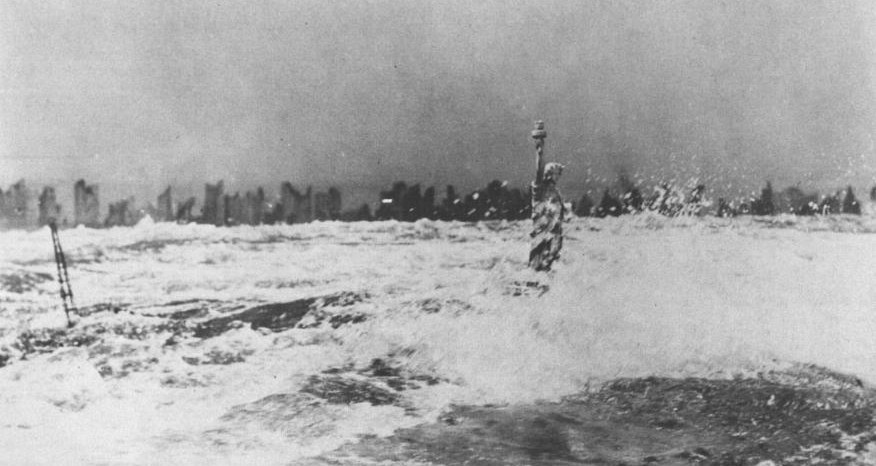
Cutting away from excited weather men, we meet the three main characters of this pre-Code curiosity: accountant Martin (Sidney Blackmer), his wife Helen (Lois Wilson) and the feisty young champion swimmer Claire (Peggy Shannon). And when introductions are done, mother nature hurls her anvil at New York City, and we get what is easily the most famous scene of the film: the destruction of the Big Apple by an enormous wave that shatters the skyscrapers as if they were glass, sending tons of concrete crashing down on panicked inhabitants, finally swallowing the city whole in its watery embrace.
We then meet up again with Claire and Martin, in that order. Claire has managed to escape thanks to her athleticism, as washes ashore in a skimpy little swimsuit (or is it underwear?) by a shack inhabited by the brute Jephson (Fred Kohler) and the shifty Norwood (Ralf Harolde). After being initially well-received, Claire realises that the two men are fighting amongst themselves about which one is going to “have” her, and efter she fights off a rape attempt from the smaller Norwood, she again drops her clothes and flees into the ocean – but with an enraged Jephson on her tail, in a boat.
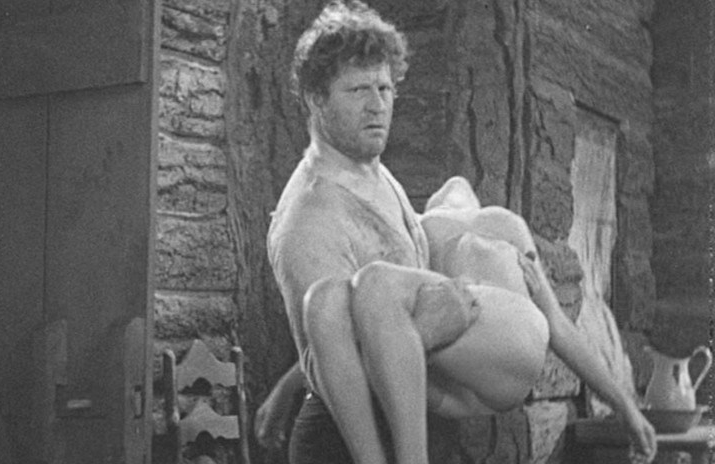
Claire then arrives at the next shack, this one inhabited by Martin, our hero, who was separated from his wife and children during the disaster, and now believes his family dead. The independent Claire slowly warms to Martin’s charms, and Martin, quick to forget his lost family, falls madly in love with Claire. In a fit of passion, Martin declares that he cannot have Claire staying with him unless she agrees to symbolically marry him then and there on the spot. Whether you call this emotional blackmail or something else, she agrees, seemingly quite willingly, and soon also professes her deep love for him. To make a long story short, Jephson somehow manages to follow Claire’s trail through the water almost directly to Martin’s shack, and also manages to find a group of bandits in the vicinity, with whom he teams up, as they are all eager to both hunt down the only free woman in the territory, as well as confiscate Martin’s supplies. This leads to a rather prolonged shootout in a mining tunnel, which is punctuated by Claire brutally pickaxing Jephson to death, at the same time as the cavalry comes to the rescue.

The cavalry, in this instance, is a group of survivors who have set up a new, fledgling society in a nearby abandoned mining town that has miraculously survived the deluge. We have previously met with the town’s unofficial leader, Tom (Matt Moore) and – in a twist that surprises no-one – Martin’s wife Helen and their children, who are very much alive. Women, as we have seen, is a scarcity in this new world, and as a result the townspeople have laid down a law according to which all women of child-bearing age must marry one of the men, in order to re-populate the Earth. And Tom, it seems, has a good eye for Helen, who has tentatively agreed to marry him, although in her heart she believes that Martin is still alive somewhere, so she stalls. And of course things become complicated when Martin arrives, alive and with a second wife by his side. But we’ll get to that in a moment.
While the problem with the two wives is momentarily on hold, Martin sorts out the problem of distributing all the loot from the mine’s storerooms among the townsfolk by using his accounting knowledge to create a credit-based bartering system. Tom sees in Martin the leader that the town has been looking for, and proposes to make him mayor of the town. But Martin refuses, saying this is something that all the inhabitants must have a say in, and so organises an election, which he naturally wins. In his acceptance speech, he lays out a future for a better world, a world not soiled by the evils of progress and civilisation: a simple world governed not by bureaucracy and committee, but by the simple truths and morals of the simple man, by cooperation and democracy and good will toward all. Hooray for Martin!

But then at the very end of the film, the romantic problem naturally needs a solution as well. Martin, although remarried, naturally can’t abandon his old wife and kids. But neither does he want to push away Claire, his new flame. The source novel, written in 1928, had a daring solution to the problem: the two women actually renounced the town’s rules and the Western/Christian tradition of monogamy, and instead chose to both remain married to Martin. Martin, naturally, didn’t complain. Despite some of the film’s otherwise rather risky pre-Code content, it draws the line at polygamy and settles for a much more boring solution, which I won’t reveal here.
For many decades Deluge took on an almost mythical reputation as a great white whale among film buffs, because of the fact that the film was considered lost. Although mildly successful at the box office, distributor RKO figured that they could make more money out of it by selling off the rights to the “spectacular” special effects scenes than re-releasing the movie, so they basically locked the film in their vault, selling the special effects footage to Republic, who used it in serials like S.O.S. Tidal Wave (1939) and King of the Rocket Men (1949). So history became legend, legend became myth, and Deluge passed out of all knowledge. Then in 1981 this original American disaster film was discovered with much fanfare in a film archive in Rome, as a nitrate print dubbed in Italian. After adding English subtitles, it was re-released on VHS and on screen at film festivals to a resounding … “meh”. Astonishingly, in 2016 an English language nitrate print was found, and restored by Lobster Films, and is now available on DVD.

Let’s address that “meh”. Deluge isn’t a bad film, in fact is a rather enjoyable one, and has a refreshingly irreverent pre-Code edge to it. But as film buffs, many of them probably not having read Sydney Fowler Wright’s source novel, were expecting high-octane disaster scenes, they a bit disappointed when in turned out that after the excitement early in the picture, it then settled for a talky and rather clumsy melodrama. In fact, “disaster film” doesn’t really do the film justice, as it should more accurately be described as a post-apocalyptic social drama.
But hey, at least those legendary scenes of the destruction of New York are awesome, right? Well … OK, they are pretty awesome, but in a sort of campy Godzilla way rather than in the way that the effects of King Kong (1933, review) are impressive even today. The crumbling of the skyscrapers is genuinely cool, but the flooding scenes are very miniaturey, and for example shots of ships being thrown around look auspiciously flimsy. The composite shots are clumsily made, albeit with some nice editing flair to hide the flaws. In one scene a very small tree, barely reaching the top of Martin’s two-story cottage, falls and completely demolishes his house, which is quite hilarious. Someone might point out that the footage was probably more impressive back in the day, which is undoubtedly true, but even Mordaunt Hall at the NY Times pointed out that some of the footage was recycled multiple times and that some of the shots of the water were badly out of focus. That said, it IS a fun and very effective sequence, especially as inter-edited with the “excited weather men”.

The rest of the film isn’t bad, but just sort of a letdown. Felix Feist directs in a flat and dull manner: some of the movie has the feel of a cheap serial, especially the tunnel shootout. The movie shows nothing of the desolated world after the flood, which the book describes in hauntingly atmospheric detail (of course, budget was an issue, but still), and most of all, the script sort of sets up cool ideas that are botched. Claire is set up as an independent take-no-shit adventurer, but completely crumbles as soon as she falls into the arms of Martin. I do respect that they at least give her the pleasure of pickaxing her would-be rapist to death, at least. It sets up a refreshingly anarchist and egalitarian picture of society, and then ruins it by showing us that the town’s two single black inhabitants are lazy and stupid. Hey, we need some comedy in the film, stick a couple of Negro jokes in there!
Another thing about this film is that it has no sense of geography or distance. Everything seems to be just around the corner. Claire swims out from one beach in broad daylight, and in the next scene we see her arriving at another beach in broad daylight. There’s no indication of how long she has been swimming, or what distance. The two beaches look virtually the same. A little while later Jephson lands with his boat on the same beach. We don’t know how he’s been able to track her through the water (??), nor how she knows that she swam ashore on that specific beach. Jephson fails to see Martin’s hut, but just literally seems to stroll over a bluff when he chances upon the band of bandits. How is it that they seem to camp just below Martin’s shack, but he’s never encountered them? Martin’s hut, the bandits’ camp, the abandoned mines and the village all seem to be within short walking distance from each other, but we never get a sense of just how close, as we seem to be magically transported from one to the other in no-time. And it’s not just the transportation and travel scenes that are missing: often it feels as if key parts of the movie have been either edited out or never written in. The most egregious omission must be that there’s no reunification scene between Martin and Helen. Martin just hugs his kids, and then that’s that.

Despite some botched ideas, the over-arching story of Deluge is original and interesting enough to make this film enjoyable. It’s not the first disaster film ever made, although some critics stubbornly refer to it as such. In 1913 Danish director August Blom made a nearly 2-hour long epic, Atlantis, about the sinking of the Titanic, and that same year Italy produced not one, but two films called The Last Days of Pompeii. Blom followed up in 1916 with the end-of-the-world epic aptly named The End of the World (review), very loosely based on Camille Flammarion’s novel of the same name. This was most probably the first post-apocalyptic film, and featured a flooded world, not unlike that described in Noah’s deluge. Abel Gance again used Flammarion’s novel for inspiration in his 1931 film The End of the World (1931, review), however, this time the film ended with the end. However, it is probably the one up to that point with the most original ideas, and it is thankfully devoid of heavy religious lecturing. A film depicting the actual Biblical deluge was Noah’s Ark, directed in 1928 by Michael Curtiz for Warner. While it was the biblical epics that he made in Germany that caught the eye of Warner, he never became the studio’s answer to Cecil B. DeMille that one might have expected: Noah’s Ark was the only Biblical epic he made in Hollywood, and that also with a modern parallel story. However, that film is best known today for Curtiz’ reckless endangering of the extras on set during the impressive flooding scenes.

Another thing that makes Deluge watchable is the decent acting from the three leads. Sidney Blackmer is stockily handsome as Martin and pulls off the job of carrying the film well, even if he is given the movie’s most bizarre character arc and dumbfounding dialogue. Blackmer would go on to become one of Hollywood’s most reliable character actors, best known for his role as the elderly cult leader/neighbour in Rosemary’s Baby (1968).
Lois Wilson almost surprisingly good in her nothing-role of Helen, showing some genuine human emotion and complexity in he sort of role that could very easily have been cardboard. Wilson was a veteran of the silent era, and one of the forgotten stars of early Hollywood, even if she, like so many others, made a successful transition into talkies. However, outshone by bigger and young stars, she spent much of the late silents and the sound era in B-movies, most of them forgotten today. She showed up in one other sci-fi film, the 1935 mad doctor romp Life Returns, opposite Onslow Stevens.

Peggy Shannon is phenomenal as Claire, and one laments the fact that nothing more was done with the role. Especially in the beginning of the film, before the character loses its edge, Shannon shines. Whatever that elusive “it” factor is that just makes some actors so loved by the camera, Shannon had it. The average film goer today probably doesn’t remember Peggy Shannon’s name, as her film career started to slide almost as soon as it began, and was tragically cut short by her death of a heart attack, brought on by a liver ailment caused by alcoholism, in 1941, when she was only 34 years old. Discovered as Broadway girl, Shannon was thrust straight into the limelight when she was brought on by Paramount to replace Clara Bow, who had suffered a nervous breakdown, in the 1932 film This Reckless Age (though she had done some minor work, mostly in shorts, prior). But pushed by the studio to work reckless hours, sometimes on multiple films at once, and under pressure to become “the new Clara Bow“, Shannon developed a severe drinking problem, and a reputation for being extremely difficult to work with. Despite a couple of semi-high profile lead roles, she was quickly being shopped around different studios and got stuck in B-movies. She returned briefly to Broadway, but was quickly replaced, “because of a tooth infection”. Already by 1933, the 26-year-old actress had developed the kind of stigma that it usually takes a decade or so to work up in Hollywood, and her career was on a downward slope, which would never improve. This does not make the work she does in the film any less impactful.

The rest of the film is filled up with mostly bit-part regulars, and there are some worthy of mention. The most recognisable is naturally Edward van Sloan, he of Universal horror movie fame, who probably doesn’t need further introduction. He is seconded by another white-haired professorial type, Samuel Hinds. Never a marquee name, Hinds was often cast as kindly authority figures, and is one of those faces that turn up in well-remembered films, whose face seems familiar, but whom you can’t really place.
Another face which will seem familiar is that of Fred Kohler’s, playing the brute Jephson. Kohler was a big man with powerful features and a menacing scowl, and the added bonus of two partly severed fingers on his right hand (reportedly due to a mining accident), and was a top pick for playing heavies in B-westerns in the twenties and thirties. Kohler does bring a certain kind of charisma to the role of Jephson, and adequately grunts his way through the movie.
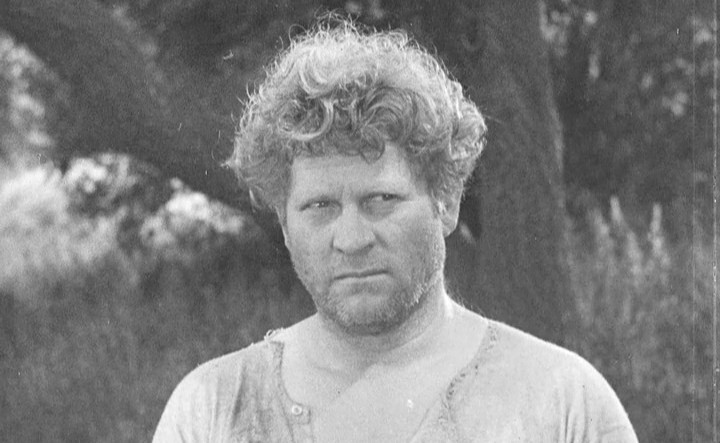
Among the uncredited performers we find John Elliott as a preacher, another prolific bit-part actor with over 300 credits in 20 years. He did a handful of appearances in science fiction productions — genre fans might want to take note of his participation in the so-bad-it’s-good debacle that is The Mad Monster (1942, review), starring the Z-team of monster movies, George Zucco and Glenn Strange, and directed by quickie specialist Sam Newfield. Fred “Snowflake” Toones plays one of the lazy, dumb black inhabitants of the utopian village, one of the many racially stereotyped performances of his career, which spanned from 1931 to 1951. Toones, or Snowflake, which was his primary stage name, was one of the most prolific black actors in the thirties and forties, inhabiting the the racist trope of the simple-minded African American with a high-pitched voice and a childlike demeanour. He appeared in over 200 films, almost always in roles such as bellboys, porters or shoeshines. His only other sci-fi credit is from The Invisible Ray (1936, review), in which he plays the native who first sees Boris Karloff glow with radioactivity.

One interesting character is Lane Chandler. Chandler is one of the many people who became Hollywood actors not so much because of any acting talent, but for their experience with horses and riding. He started getting small parts in the late twenties, and was quickly catapulted into second leads and even the occasional first lead in fairly high-profile movies, acting opposite stars like Gary Cooper, Clara Bow, Wallace Beery, Fay Wray, Greta Garbo and Nils Asther. In 1930-1932 he had a short string of heroic leading roles in B-westerns, but his stardom was cut short as abruptly as it had started, as it was clear that his lack of experience with speaking roles made him ill suited as dramatic lead in the talkie era. While steadily employed in film and TV until the early sixties, he was mostly relegated to uncredited bit-parts or minor supporting characters, with the odd exception in Poverty Row westerns. Considering that he is primarily remembered as a western actor today, Chandler was involved in a surprising number of science fiction productions. He appeared in all the major SF serials of the late thirties and early forties, including The Phantom Empire (1935), Flash Gordon (1936, review), Undersea Kingdom (1936, review), The Phantom Creeps (1939), Buck Rogers (1939), The Green Hornet (1940) and The Purple Monster Strikes (1945). He also had small roles in the feature films Invisible Agent (1942, review), The Lady and the Monster (1944, review), Creature with the Atom Brain (1955, review) and Space Master X-7 (1958).

As stated, Deluge is based on British author Sydney Fowler Wright’s 1928 novel of the same name. It is sometimes described as the first modern novel to use the Biblical theme of the Flood in depicting a cataclysmic event, but this is not the case. Wright was preceded here by at least Garrett P. Serviss, whose novel The Second Deluge was published in 1912. Serviss goes as far as to having a modern Noah (a scientist) build an ark for a chosen few to survive the deluge. Serviss was an astronomer, and described at length and in detail the science behind his flood. Wright was a poet and accountant, and cared little for the scientific reasons for the deluge, just like in the film, the novel simply presents the cataclysm as a fact that has scientists befuddled.
Wright was still a rather unknown name when Deluge was published. He had put out some poetry and one moderately successful science fiction novel called The Amphibians (1924), in which amphibians had inherited the Earth after humans. Although his debut had garnered some positive reviews, he wasn’t able to sell his second novel to any publisher, and thus decided to put it out through his own publishing company. When it turned out to be a best-seller, it was picked up by Cosmopolitan Books for mass distribution. Wright went on to publish over a dozen more SF books between 1930 and 1954. None of them are particularly well-known today outside of genre fans, but Wright has been characterised by author and scholar Brian Stableford as the “most important British SF writer between H.G. Wells and the moderns”.

A common theme in Wright’s books is the moral degeneration of man through progress, civilisation and industrialisation. Wright was a conservative political activist who thought that the comforts of the modern age had turned humans lazy and self-centered, and that so-called progress was a progress for machines rather than for mankind. He abhorred bureaucracy as a repression of the individual, and saw communism as the ultimate tool of repression. This in stark contrast to socialist H.G. Wells, who wrote extensively about how mankind’s ultimate salvation would come from the marriage of socialism and science into a form technocracy. This theme is strong in Deluge, and it’s carried on to the film almost undiluted. The book does have a lenghtier discussion on breaking free from the social and religious norms of society in the end, where the case of polygamy comes up. The film touches on it, but only to swiftly discard it, although it must be admitted that the film’s ending is certainly more cinematic. I wasn’t personally as impressed with the novel as some SF scholars and critics have been: I found the characterisations very bland and the book on a whole a bit dry, ironically. Unfortunately I also found it rather prejudiced and thought the female characters in particular were unrealistically written. Now, in a Burroughs book you accept the latter on the premise of it being cheap pulp, but since this novel sets a “nobler” goal, I also hold its literary values under a larger microscope. That said, it is an essential book for the avid SF reader, and has its moments of brilliance, especially in the descriptions of the flooded London area. It’s also refreshing to have a both physically and mentally strong and active female character.

Unfortunately the film cuts out one of my favourite parts of the book, which is Claire’s struggle against drowning on her long swim, and her subsequent arrival at a house inhabited by an old stoic and his daughter. I realise why they cut it: It’s non-essential for the plot, but still a pity. One logical adaptation is that the setting of the story has been changed from London to New York. Another major change from the novel is that in the book Jephson doesn’t follow Claire after the attempted rape. From a cinematic point of view the change is also understandable, as the filmmakers wanted to have a clear-cut villain in the film. It does strain credibility, though.
Another issue that strains credibility both in book and film is the lack of women in the new society. Why have such an disproportionately large number of women died in the deluge? This is a central story element, but it is never explained. The underlying logic is naturally that women as “the weaker sex” would have succumbed to the hardships of the disaster in larger numbers than men, but this doesn’t really make sense. Sure, in a touch-and-go situation someone with greater physical strength might stand a slightly better chance of climbing a tall building or swimming long distances, but that’s just not how a tsunami works. Either you’re in a situation where you’re able to save yourself or then you’re not. When a mudslide hits you or a skyscraper tumbles on top of you, it really doesn’t matter how much you bench-press. If anything, women should have stood a greater chance of outnumbering men after the deluge, since in the thirties they would have made up a significantly smaller number of first responders, the military and other groups which would have deliberately put themselves in harm’s way.
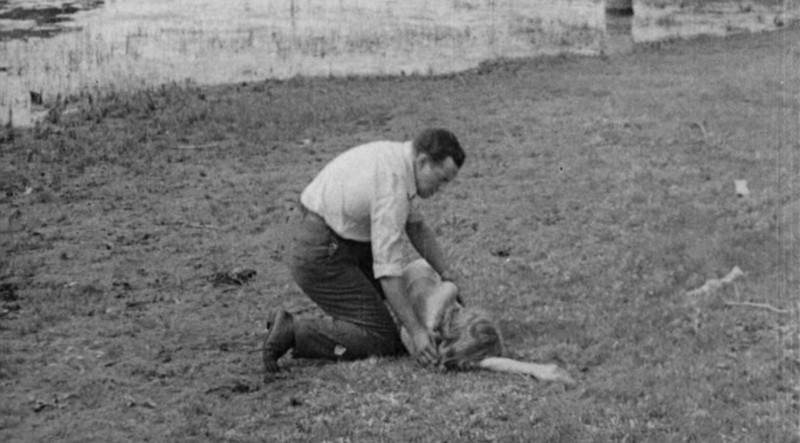
Then there’s the idea that a tsunami would wipe away all the continents of the world, that is, of course, ridiculous. Garrett P. Serviss actually dealt with this in his book in a satisfactory way: Without getting into specifics, his general idea was that the amount of existing water on Earth suddenly multiplied because of our planet’s collision with a “watery nebula”. Wright doesn’t explain the cause of his storm, which is all fair, sometimes no explanation is better than a bad one: but the problem is that he tries to eat his cake and have it. If you create a floodwave that is so immensely powerful that it kills dead basically everyone on the planet — including those who live 5 000 feet above sea level and hundreds of miles from the nearest coast — you can’t have the sole survivors living in coastal areas like London or New York. If you’re able to swim(!) to safety in New York, then surely the good people of Colorado or North Dakota can’t even have gotten the soles of their shoes wet?

These illogical twists don’t ruin the film, but they are glaring enough to make the viewer stop and think, which does pull you out of the experience somewhat. Combined with other plot holes and odd character motivations (the world just ended, and you’re going to spend your time and energy chasing down and killing a girl you’ve just met because she wouldn’t let you rape her?) they do make for a rather contrived viewing experience. The book, like the film, play with the idea of mankind saved from the sin-eating flood in order to start anew, making a better world. But especially the film loses its moral edge by making this new society not so much a new garden of Eden, as a free-for-all rape-and-kill-fest. If this new, simpler society is supposed to bring out the best in man, then should we look to Jephson or the bandits for role models? Or the townspeople who would happily turn over their power to the first dictator who comes along with a degree in accounting? In fact, when Tom takes a posse to wipe out the bandits, he explicitly tells the townsmen not to rape the women while they’re gone. Now, tell me again how this is a better society. I’m not going to go into politics here, but even based on its own logic, Wright’s vision for society seems clouded. Again, this sort of thing I’d happily glance over in a film where the main plot revolves around fighting green men from Mars, but as the whole book is one massive social statement, it must also hold up to scrutiny.

That said, for all its flaws and shortcomings, Deluge is an entertaining enough disaster movie, and an interesting addition to the post-apocalyptic subgenre, as Mordaunt Hall writes: a “rumbling and gurgling thriller”. Although he adds: “The dialogue never rises above the action of the story and the players deserve sympathy.” Paul Mavis at the DVD Drive-In states that the destruction scenes in the beginning are impressive for their time, but that the rest of “the post-apocalypse survival storyline is unfortunately less successful”. Richard Scheib at Moria reprises this sentiment: “The downside is that the film gives us its best scene at the start. The rest of it slips into being a fairly standard post-holocaust and Last People on Earth story.”
Jim Tudor at Zekefilm writes: “To watch Deluge, in all its base-level pandering, is to confront the reality that movie allure hasn’t altogether cheapened since Hollywood’s golden age. Collectively we carry a notion that movies in the 1930s were classy, unlike today when we’ve lost out to the likes of Transformers, The Day After Tomorrow, and San Andreas. Deluge is ambitious, unapologetic proof that if they could’ve made Transformers movies in 1933, replete with high-end mass destruction and Megan Fox bending over motorcycles, all for the lowest common denominator, they likely would’ve been. […] Deluge […] demonstrates that even on a meager budget and mishandled and disregarded by its parent studio at every turn, Hollywood storytellers were keen to realize the B-movie model as A-movie spectacle.”

I don’t have much more to add to the above statements about the film. It’s a decent B-roll and would perhaps be regarded as a minor rough gem today if it wasn’t for the fact that it was so hyped for the many years it was considered lost, on the basis of the surviving effects in other works, that many film buffs were slightly underwhelmed when it was finally unearthed. It has moments where Russell Lawson’s matte paintings create an eerie, desolate atmosphere, but director Felix Feist simply doesn’t have the budget or the chops to turn the script into anything more than the words on the page, and the direction is mostly prosaic. And hack screenwriters John Goodrich and Warren Duff fall back on the novel, without adding much in the terms of a vision of their own, which in its own way can be commended. It’s just that in not choosing a clear thread to focus on, the script becomes a bit meandering and rudderless. They have tried turning the throw-away character of Jephson from the book into the main antagonist of a plot that doesn’t have a main antagonist, but without attaching Jephson to the political and philosophical ruminations of the story, the whole thing becomes somewhat lop-sided. For two thirds of the film we worry about Claire being hunted by Jephson, and when he is killed, it feels like the emotional climax of the movie, although at this point we already know that Helen is alive, so we know that the Helen/Claire situation must also come to a head. Unfortunately the screenwriters still try to sandwich in the third story, which was the main theme of the book, namely the rebuilding of society with Martin getting elected mayor, and so forth — leaving the Helen/Claire situation dangling awkwardly for a good amount of time. Simply put: the film is just sloppily structured.

Deluge was produced by Samuel Bischoff, Burt Kelly and William Saal for the aptly named K.B.S. Productions, a Poverty Row company put together by Bischoff in 1931 after working for a number of years as head of production for Columbia. Kelly and Saal were both fresh faces in the industry, and he latter would disappear from the scene pretty soon after K.B.S. disbanded in 1933. Kelly is best known today for producing three B-horror comedies for Universal in the early forties starring Boris Karloff, Bela Lugosi and Basil Rathbone: Black Friday (1940), The Invisible Woman (1940, review) and The Black Cat (1941). Bischoff later worked for Warner, Columbia and RKO, turning out mostly B-movies. He was already known in Hollywood in 1933 as an efficient producer able to churn out passable films for a low cost. Thus RKO felt fairly secure when they entered into collaboration with K.B.S. over Deluge, with a very modest budget of 75 000 dollars. However, due to Feist’s elaborate special effects and other factors, the budget ballooned to around 175 000 dollars. RKO had counted on making a modest profit on the budget of 75 000, but ended up losing money instead, which is why they later hawked out its special effects sequences to other films. Whatever the overall qualities of the film, the images of New York being hit by a tsunami have ingrained themselves in the pop-cultural subconscious, and were reportedly used as a template for a similar scene in the 2004 disaster film The Day After Tomorrow.

If the feeling of the film is that the direction is a bit shaky, then it could be explained by the fact that this was director Felix E. Feist’s feature film debut. Feist was born into Hollywood, as his father was a sales manager at MGM, and started out doing numerous small jobs in the movie industry in the late twenties, getting his first credits as composer and lyricist, and worked uncredited on a few screenplays. He had only directed one short film in 1933, at the time only 23 years old, when he was shoved into the limelight with Deluge — with the hopeless job of creating an apocalyptic epic on pocket change. In retrospect, the only director who would take on the task would probably have been an inexperienced and energised young lad who didn’t know enough to see that the task was impossible — which it proved to be as the film went twice over budget. One educated guess is that Feist had tremendous help by seasoned cinematographer Norbert Brodine, who went on to become nominated thrice for Oscars and won an Emmy. The man responsible for the special effects was Ned Mann, who in 1936 directed the SFX for the flawed epic that was William Cameron Menzies’ and H.G. Wells’ Things to Come (review).
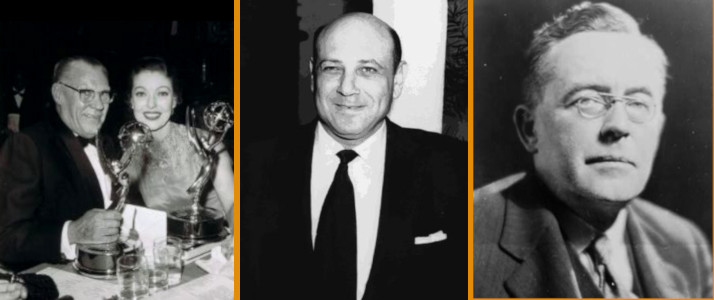
In the thirties Feist only made short movies for MGM. In 1943 he moved to Universal and later RKO, and started directing feature films, most of which are either forgotten or forgettable. In the beginning of the fifties he went freelance on Poverty Row, before turning to television in 1953. His best known film is one of his very last, the science fiction cult classic Donovan’s Brain (review), based on the 1942 novel by horror legend Curt Siodmak. In 1965 he directed an episode for the TV series The Outer Limits, and in 1964-1965 a handful of episodes of Voyage to the Bottom of the Sea. However, he is best known in TV for producing the series The Californians (1957-1959) and Peyton Place (1965).

Interestingly enough, it was author S. Fowler Wright who originally pitched Deluge the movie to Hollywood, complete with a script that he had written himself. K.B.S./RKO ended up not using his script, and even though the film stays pretty close to the book, Wright was reportedly very critical of the changes made. He especially took affront to the changes to the ending of the movie. According to Brian Stableford he wrote in his diary “that he felt the film was ‘ghastly’ and advised his children not to see it”.
The film is available since 2017 on a Kino Lorber Blu-ray, which some reviewers have been rather enthusiastic about.
Janne Wass
Deluge. 1933, USA. Directed by Felix E. Feist. Written by John Goodrich & Warren Duff. Based on novel by Sydney Fowler Wright. Starring: Peggy Shannon, Lois Wilson, Sidney Blackmer, Matt Moore, Fred Kohler, Ralf Harolde, Edward van Sloan, Samuel S. Hinds, Lane Chandler, John Elliott, Fred “Snowflake” Toones. Music: Val Burton. Cinematography: Norbert Brodine. Editing: Rose Loewinger. Settings: Ralph M. DeLacy. Sound engineer: Corson Jowett. Special effects: Ned Mann, Russell Lawson, William Williams. Produced by Samuel Bischoff, Burt Kelly & William Saal for K.B.S. Productions.

Leave a comment